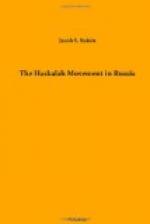The liberal current which had carried away his predecessors when they first mounted the throne was checked, the sluices of Slavophilism were opened, the history of Russian thinkers became again, as Herzen said, “a long list of martyrs and a register of convicts.”
Nicholas Ignatiev, a rabid reactionary, a second Jeffreys, became chief of the Ministry of the Interior; Katkoff, a repentant liberal and exile, was appointed the czar’s chief adviser, the Richelieu behind the throne; and Pobyedonostsev, whom Turgenief called the “Russian Torquemada,” obtained supremacy over Melikoff, and was appointed procurator of the Holy Synod. With such as these at the head of the Russian bureaucracy, there may have been some foundations for the rumor that an imperial ukase decreed the pillage and slaughter of the Jews, and the muzhiks, obedient to the behests of the “little father,” and smarting under the pain of disappointment, vented their venom on their Jewish compatriots. Before the new czar had been on his throne three months, Russia was drenched with Jewish blood. There began saturnalia of rape, plunder, and murder, the like of which had been witnessed nowhere in Europe. For half a year the pogroms which began in Yelisavetgrad (April 27, 28) swept like a tornado over southern Russia, visiting more than one hundred and sixty communities with fire and sword, resulting in outrages on women, in the murder of old and young, in the ruin of millions of dollars of property. The Black Hundreds of the nineteenth century put to shame the Haidamacks of the eighteenth and the Cossacks of the seventeenth. In the words of the Bishop of Canterbury to Sir Moses Montefiore, it looked “as if the enemy of mankind was let loose to destroy the souls of so many Christians and the bodies of so many Jewish people.”
But it would be a vain attempt, and out of keeping with the object of this work, to describe in detail the “bloody assizes” and the infernal tragedies that ensued upon the accession of Alexander III; the moral degeneracy and the economic ruin that spread over the mighty empire; the shudder that passed over the civilized world, and was expressed in indignation meetings held everywhere, especially in Great Britain and in the United States (February, 1882), to protest, “in the name of civilization, against the spirit of medieval persecution thus revived in Russia.” Suffice it to say that even when the mob, tired of carnage, ceased its work of extermination, the bloodthirstiness of those in authority was not assuaged. Such a policy was inaugurated against the Jews as would, according to Pobyedonostsev, “force one-third of them to emigrate, another third to embrace Christianity, and the remainder to die of starvation.” With this in view, his Majesty the Emperor, “prompted by a desire to protect the Jews against the Christians,” was graciously pleased to give his assent to the Resolutions of the Committee of Ministers, on the third of May, 1882, i.e. to the notorious “temporary measures,” or “May laws,” framed by Ignatiev, against the will of the Council of the Empire.




